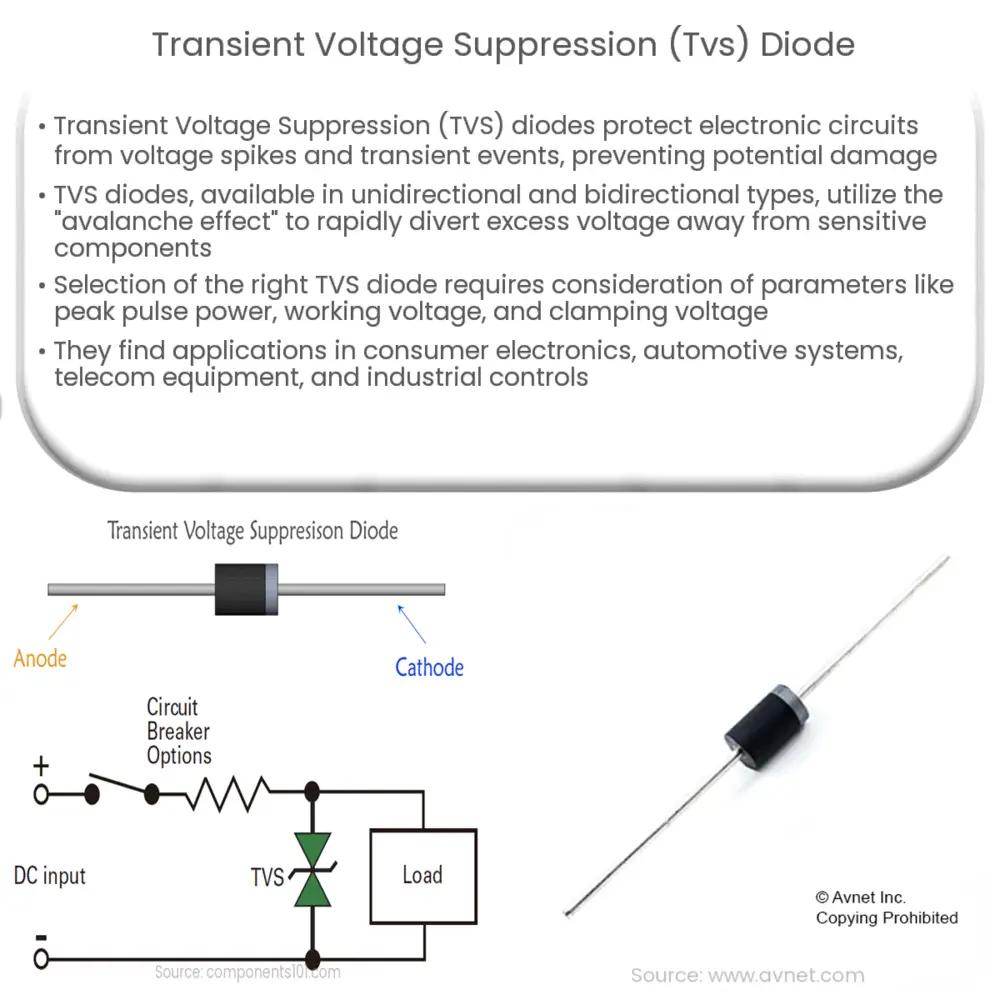TVS diodes protect electronic circuits from voltage spikes, diverting excess voltage to prevent damage to sensitive components.

Transient Voltage Suppression (TVS) Diodes: An Essential Guide
Introduction
Transient voltage suppression (TVS) diodes are essential components in electronic circuits that provide protection against voltage spikes and transient electrical events. These events, if left unchecked, can cause severe damage to sensitive electronic devices and systems. In this article, we will explore the basics of TVS diodes, their applications, and how they function to provide effective protection against transient voltages.
What are Transient Voltage Suppression Diodes?
TVS diodes, also known as transient voltage suppressors or avalanche diodes, are semiconductor devices specifically designed to protect electronic circuits from high-voltage transients. They are commonly used in a wide range of applications, including consumer electronics, automotive systems, telecommunications equipment, and industrial control systems. TVS diodes can shunt excess voltage away from sensitive components, limiting the voltage to a level that is safe for the protected circuit.
How Do TVS Diodes Work?
TVS diodes operate by utilizing a phenomenon called the “avalanche effect. When a voltage spike occurs, the TVS diode goes into avalanche mode and starts to conduct current. This action effectively diverts the excess voltage away from the sensitive components in the circuit, preventing damage or malfunction. Once the transient voltage event subsides, the TVS diode returns to its non-conductive state, and the circuit resumes normal operation.
TVS diodes can respond rapidly to transient voltage events, making them an ideal solution for protecting against fast-rising voltage spikes. Their response time is typically in the order of picoseconds, enabling them to provide effective protection against even the most abrupt transients.
Types of TVS Diodes
There are two primary types of TVS diodes: unidirectional and bidirectional. The choice between the two depends on the specific application and the nature of the voltage transients to be protected against.
Unidirectional TVS Diodes
Unidirectional TVS diodes are designed to suppress voltage transients in a single direction. They are commonly used in circuits where voltage spikes only occur in one direction, such as DC power supplies. Unidirectional TVS diodes offer lower clamping voltages, faster response times, and better performance in high-frequency applications than their bidirectional counterparts.
Bidirectional TVS Diodes
Bidirectional TVS diodes, as the name suggests, can suppress voltage transients in both positive and negative directions. They are ideal for use in circuits where voltage spikes can occur in either direction, such as AC power lines or data communication lines. Although bidirectional TVS diodes may have slightly higher clamping voltages and slower response times compared to unidirectional diodes, they provide the advantage of protecting against both positive and negative voltage transients.
Selecting the Right TVS Diode
Choosing the appropriate TVS diode for a specific application involves several factors, including the maximum transient voltage, the required response time, the power dissipation capability, and the clamping voltage. It is crucial to consider these parameters to ensure that the TVS diode provides adequate protection without affecting the overall performance of the circuit.
Key Parameters to Consider
When selecting a TVS diode for your application, it is essential to consider the following key parameters:
1. Peak Pulse Power (Ppp)
The peak pulse power is the maximum power that the TVS diode can safely dissipate during a transient voltage event. It is essential to choose a diode with a Ppp rating that exceeds the expected transient energy to ensure the diode can handle the transient without damage.
2. Working Voltage (Vwm)
The working voltage is the maximum steady-state voltage that the diode can withstand without conducting current. The Vwm should be slightly higher than the normal operating voltage of the protected circuit to avoid unnecessary conduction during regular operation.
3. Clamping Voltage (Vc)
The clamping voltage is the maximum voltage that the TVS diode will allow to pass through the circuit during a transient event. It is crucial to select a diode with a clamping voltage that is low enough to protect sensitive components but high enough to avoid false triggering during normal operation.
4. Breakdown Voltage (Vbr)
The breakdown voltage is the voltage at which the diode begins to conduct current. This parameter is typically specified within a range, with a minimum (Vbr(min)) and maximum (Vbr(max)) value. It is important to choose a diode with a breakdown voltage range that provides adequate protection while minimizing the risk of false triggering.
TVS Diode Applications
TVS diodes are used in various applications to protect sensitive electronic components and systems from transient voltage events. Some common applications include:
- Consumer electronics (smartphones, laptops, televisions, etc.)
- Automotive electronics (ECUs, sensors, infotainment systems, etc.)
- Telecommunications equipment (base stations, routers, switches, etc.)
- Industrial control systems (PLCs, motor drives, sensors, etc.)
- Power supplies (AC/DC converters, voltage regulators, etc.)
- Data communication lines (Ethernet, USB, RS-232, etc.)
Conclusion
Transient voltage suppression (TVS) diodes are an essential component for protecting electronic circuits from voltage spikes and transient events that can cause severe damage or malfunction. By understanding the key parameters and selecting the appropriate TVS diode based on the specific application requirements, engineers can ensure the reliability and longevity of their electronic systems. With a wide range of available options, including unidirectional and bidirectional diodes, TVS diodes offer a versatile and effective solution for safeguarding sensitive electronics against transient voltage events.

